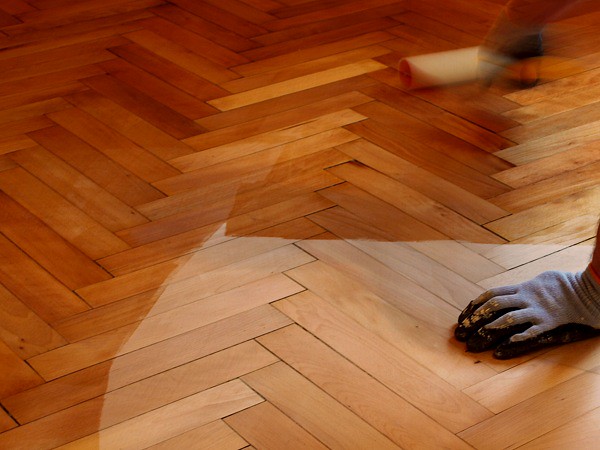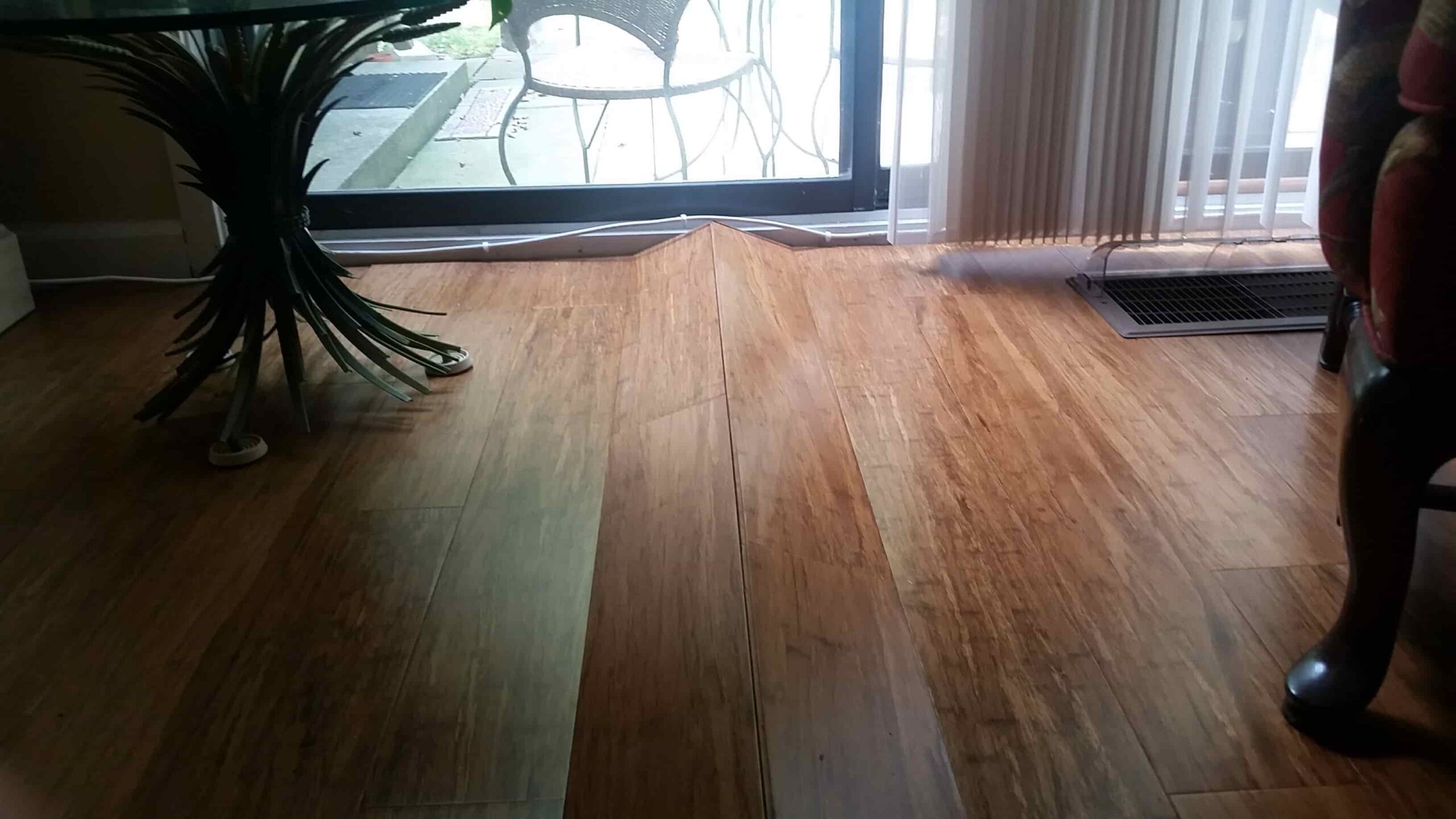Flooring can add not only beauty and comfort to a home but also value. When making a decision about what type of flooring to install in your home, it is important to consider the many factors that will affect your choice.
Cupped wood floors are a common issue that many homeowners face. This problem occurs when the boards on a hardwood floor curve upwards at the edges, creating a “cup” shape.
While cupping is often seen as an aesthetic issue, it can also indicate potential structural problems with the flooring. As such, many homeowners wonder whether their cupped wood floors will flatten out over time.
In this article, we will discuss the causes of cupping in wood floors and whether or not they will flatten out on their own. We will also explore potential solutions for fixing cupped wood floors and preventing them from occurring in the first place.
Hardwood Floor Cupping?

Cupped wood floors are the bane of many a homeowner’s existence. But what exactly is cupping?
Simply put, cupping occurs when the boards of a hardwood floor start to curl up at the edges, creating a cup-like shape.
This can happen for a number of reasons, including moisture imbalances, overly dry conditions, or even poorly manufactured boards. The cupping can also be caused by spills or leaks that aren’t cleaned up quickly enough.
Regardless of the cause, cupped floors are unsightly and can be difficult to fix. In some cases, the cupping may be mild and barely noticeable. However, in other instances, the boards may be so severely cupped that they start to buckle and warp.
Can you Fix the Hardwood Floor Cupping?
Luckily, cupped floors can often be fixed. If the cupping is severe, you may need to replace some of the boards. But in many cases, simply sanding down the floor and refinishing it will take care of the issue. So if you have a cupped hardwood floor, don’t despair – there’s hope!
But your best way is to call in a professional flooring contractor (NWFA certified) who can assess the extent of the damage and recommend the best course of action. With their help, you can get your floors looking like new again in no time.
How to Fix a Cupped Hardwood Floor?
There is no need to panic if you find yourself with a cupped hardwood floor. In most cases, the problem can be easily fixed with a little elbow grease and the right know-how.
The first step is to determine the cause of the problem. If your wood floor is cupping due to high humidity, you will need to take measures to reduce the moisture in your home. This may involve investing in a dehumidifier or using fans and air conditioners to keep the air circulating.
If your wood floor is cupping due to improper cleaning, you will need to be more careful in the future. Avoid using excessive water or harsh cleaning chemicals, and make sure to dry the floor thoroughly after washing it.
Once you have addressed the underlying issue, you can begin fixing the cupped hardwood floor itself. The most important thing to remember is to work slowly and carefully so as not to damage the wood.
Start by sanding down the raised edges of the boards until they are level with the rest of the floor.
If necessary, you may also need to sand down some of the boards in the middle of the floor so that they are flush with the rest of the surface.
Once you have finished sanding, vacuum up any dust and then apply a new coat of finish. With a little time and effort, you should be able to fix a cupped hardwood floor and restore it to its previous condition.
Factors Affecting Cupping in Wood Floors
Discussion on Moisture Imbalance
The root cause of cupping in wood floors is moisture imbalance. When the moisture levels in the environment exceed those of the wood, the wood absorbs the excess moisture causing it to swell and expand.
This expansion is uneven as it is generally greater on the top of the wood than on the bottom, leading to the edges rising up and forming a cup-like shape.
This moisture imbalance can stem from a variety of sources such as high humidity, lack of ventilation, or direct water damage from spills or leaks.
In regions with distinct seasonal changes, fluctuations in humidity throughout the year can also cause repeated instances of cupping and flattening.
Furthermore, the moisture content of the wood at the time of installation plays a significant role in future cupping. If the wood’s moisture content differs greatly from the average humidity of the environment in which it is installed, it is likely to warp and cup as it acclimates to its new surroundings.
Proper acclimation and moisture control before and during installation are therefore key to preventing cupping in wood floors.
Impact of Environmental Factors
Environmental factors can play a significant role in the cupping of wood floors. Changes in temperature and humidity levels, in particular, have a profound effect. When the air is humid, wooden floors absorb moisture, causing them to expand.
During dry periods, the floors contract as they release moisture back into the environment. This continual expansion and contraction can lead to cupping over time. High humidity levels, especially during summer months or in tropical climates, can speed up this process, resulting in more pronounced cupping.
Similarly, temperature affects the moisture content of the wood. Higher temperatures can cause the wood to dry out and shrink, leading to gaps in the flooring. Therefore, maintaining a consistent indoor climate is crucial in preventing such deformities in wood floors.
Additionally, direct sunlight can heat the wood surface unevenly, contributing further to moisture imbalance and cupping.
Relation Between Installation Methods and Cupping
The method of installation can significantly influence the likelihood of wood floors cupping. For instance, if the wood flooring is not properly acclimated to the environment before installation, it can lead to moisture imbalance and subsequent cupping.
Similarly, incorrect subfloor preparation can create an uneven base for the wood floor, exacerbating the propensity for cupping. Furthermore, nailing techniques play a crucial role.
If the nails are not driven correctly or are spaced too far apart, it can allow for more movement in the wood, leading to cupping over time. In contrast, a well-executed glue-down method can provide a more stable base and reduce the risk of cupping.
Therefore, it’s essential to rely on experienced professionals for the installation of wood flooring. Proper installation techniques can help in managing the moisture levels in the wood and mitigate the potential for cupping.
Will Cupped Wood Floors Flatten Out Over Time?
Yes, it is possible for cupped wood floors to flatten out over time, but this largely depends on the severity of the cupping and the conditions of the environment.
In situations where the cupping is caused by temporary fluctuations in humidity levels, for example, during a particularly humid summer, the wood may flatten out naturally as the moisture levels in the environment decrease.
However, it’s important to note that this recovery process is usually slow. In more severe cases, where the cupping is a result of significant water damage or long-term humidity imbalances, the flooring may not return to its original state without professional intervention.
In these circumstances, sanding and refinishing the floor might be required after the moisture issue has been fully addressed.
Time Periods for Natural Recovery
The time it takes for cupped wood floors to flatten out naturally can vary significantly based on several factors. In mild cases where cupping is caused by temporary humidity fluctuations, natural recovery may occur within a few weeks to months as the seasons change and humidity decreases.
However, it’s crucial to maintain a consistent indoor climate during this period to facilitate recovery. On the other hand, in more severe cases resulting from long-term humidity imbalances or water damage, the floor may never flatten out completely without professional intervention.
Even after addressing the moisture issue, it could take many months for noticeable improvement, and full recovery may not be guaranteed.
Factors Affecting the Recovery Process
There are a multitude of factors that can influence the recovery process of cupped wood floors.
The extent of Damage: The degree of warping or cupping substantially impacts the recovery time. Severe cases may require more time to flatten out, or might not recover without professional help.
Type of Wood: Different wood types react differently to moisture and, consequently, to the drying process. Some types of wood are more resistant to moisture changes and may recover faster.
Age and Condition of the Floor: Older floors or those in poor condition may have a more prolonged recovery process. In contrast, newer and well-maintained floors will likely recover more quickly and effectively.
Climate and Humidity Control: The speed and success of the recovery process are heavily dependent on maintaining an ideal and consistent indoor humidity level.
Preventive Measures and Remedies
Preventing wood floor cupping primarily involves proactive measures aimed at maintaining consistent indoor humidity levels and protecting the floor from potential water damage.
Regular Maintenance: Regular cleaning using appropriate wood floor cleaning products can help maintain the quality and longevity of your floors, thus making them less likely to cup.
Proper Installation: Ensure the wood is properly acclimatized to the indoor environment before installation to avoid subsequent moisture-related issues.
Moisture Barriers: Consider using effective moisture barriers or underlays during installation, particularly in areas prone to high humidity or potential water spillages like bathrooms or kitchens.
Climate Control: Install a quality HVAC system to maintain consistent indoor humidity levels, ideally between 35% and 55%. Consider using dehumidifiers during wet seasons if necessary.
Immediate Action: Respond quickly to any spills, leaks, or floods to prevent moisture from seeping into the wood and causing cupping.
When to Seek Professional Help
There are certain circumstances when it’s best to call in a professional to handle cupped wood floors. If the cupping is extensive, severe, and affects large areas of the floor, a professional can ensure the correct and safe restoration of the flooring.
Professionals can also accurately identify the moisture source causing the cupping, an essential step that can be challenging for homeowners.
If your efforts to control humidity and flatten minor cupping haven’t yielded results over time, this can be a sign that you need professional assessment. Lastly, if your floors require sanding, this process can be complicated and messy and is best left to professionals.
Conclusion
In conclusion, dealing with cupped wood floors can be a demanding task. It is crucial to identify the source of the problem, which is usually tied to moisture imbalance, and apply the appropriate solutions, from sanding and refinishing to the replacement of damaged planks.
A humidifier or dehumidifier can be instrumental in restoring the right humidity levels. However, for severe and extensive cupping, professional help is recommended as they can provide a comprehensive assessment and efficient solutions.
While these methods may require time and patience, they are necessary to preserve the lifespan and aesthetic of your wood floors. Remember: swift and effective action can prevent further damage and save you from substantial expenses down the line.
Related Topic: 11 Best Wood Stairs Ideas: Let’s Uncover
FAQ
How long does it take for hardwood floors to Cup?
Ever wonder how long it takes for those pesky wood floors to start cupping? Well, the answer may surprise you! Cupping occurs when the wood fibers on the surface of the floor absorb more moisture than the fibers on the bottom. So, it takes one or two days for noticeable cupping.
How long for cupped floors to dry?
It depends on the condition of the flooring. If the moisture level is too high and the wood is fully wet then it takes weeks to fully dry out. However, if you find the moisture earlier then it will take two to three days to fully dry out.

